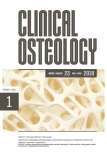Hypophosphatemic rickets linked to the X (XLH) chromosome – KRN 23 (burosumab) therapy: expert opinion of the Society for Metabolic Bone Diseases within the Czech Medical Association of J.E. Purkyně
Authors:
Palička Vladimír; Bayer Milan; Rosa Jan; Kutílek Štěpán
Published in:
Clinical Osteology 2018; 23(1): 38-41
Category:
Overview
Received 5. 9. 2018
Sources
-
Burnett CH, Dent CE, Harper C et al. Vitamin D-Resistant Rickets. Analysis of Twenty-Four Pedigrees with Hereditary and Sporadic Cases. Am J Med 1964; 36 : 222–232.
-
Imel EA, Econs MJ. Fibroblast growth factor 23: roles in health and disease. J Am Soc Nephrol 2005; 16(9): 2565–2575.
-
Beck-Nielsen SS, Brock-Jacobsen B, Gram Jet al. Incidence and prevalence of nutritional and hereditary rickets in southern Denmark. Eur J Endocrinol 2009; 160(3): 491–497.
-
Rafaelsen SH, Johansson S, Raeder H et al. Hereditary hypophosphatemia in Norway: a retrospective population-based study of genotypes, phenotypes and treatment complications. Eur J Endocrinol 2015; 174(2): 125–136.
-
Endo I, Fukumoto S, Ozono K et al. Nationwide survey of fibroblast growth factor 23 (FGF23)-related hypophosphatemic diseases in Japan: prevalence, biochemical data and treatment. Endocr J 2015; 62(9):811–816.
-
Carpenter TO. New perspectives on the biology and treatment of X-linked hypophosphatemic rickets. Pediatr Clin North Am 1997; 44(2): 443–466.
-
de Paula FJ, Rosen CJ. Bone Remodeling and Energy Metabolism: New Perspectives. Bone Res 2013; 1(1): 72–84.
-
Knochel JP. The pathophysiology and clinical characteristics of severe hypophosphatemia. Arch Intern Med 1977; 137(2): 203–220.
-
Glorieux FH, Marie PJ, Pettifor JM et al. Bone response to phosphate salts, ergocalciferol, and calcitriol in hypophosphatemic vitamin D-resistant rickets. N Engl J Med 1980; 303(18): 1023–1031.
-
Imel EA, DiMeglio LA, Hui SLet al. Treatment of X-linked hypophosphatemia with calcitriol and phosphate increases circulating fibroblast growth factor 23 concentrations. J Clin Endocrinol Metab 2010; 95(4): 1846–1850.
-
Carpenter TO, Imel EA, Holm IA et al. A clinician’s guide to X-linked hypophosphatemia. J Bone Miner Res 2011; 26(7): 1381–1388.
-
Beck-Nielsen H. The metabolic syndrome in the daily clinic. Ugeskr Laeger 2010; 172(23): 1746–1751.
-
Berndt M, Ehrich JH, Lazovic D et al. Clinical course of hypophosphatemic rickets in 23 adults. Clin Nephrol 1996; 45(1): 33–41.
-
Hardy DC, Murphy WA, Siegel BA et al. X-linked hypophosphatemia in adults: prevalence of skeletal radiographic and scintigraphic features. Radiology 1989; 171(2): 403–414.
-
Reid IR, Hardy DC, Murphy WA et al. X-linked hypophosphatemia: a clinical, biochemical, and histopathologic assessment of morbidity in adults. Medicine (Baltimore) 1989; 68(6): 336–352.
-
Whyte M et al. Burosumab (KRN23), a Fully Human Anti-FGF23 Monoclonal Antibody for X-linked Hypophosphatemia (XLH): Final 64-Week Results of a Randomized, Open-label Phase 2. Study of 52 Children. Oral presentation 1154. The Annual American Society for Bone and Mineral Research Meeting 2017; Denver, CO, USA.
-
Carpenter TO et al. Effects of Burosumab (KRN23), a Fully Human Anti-FGF23 Monoclonal Antibody, on Functional Outcomes in Children with X-linked Hypophosphatemia (XLH): Final Results from a Randomized, 64-week, Open-label Phase 2 Study Oral presentation 331. The Annual American Society for Bone and Mineral Research Meeting 2017; Denver, CO, USA.
-
Imel EA et al. Oral presentation at the ICCBH 2017; Würzburg, Germany.
-
Imel EA et al. The Effects of Burosumab (KRN23), a Fully Human Anti-FGF23 Monoclonal Antibody, on Phosphate Metabolism and Rickets in 1 to 4-Year-Old Children with X-linked Hypophosphatemia (XLH). Oral presentation 695. The Annual American Society for Bone and Mineral Research Meeting 2017; Denver, CO, USA.
-
Makitie O, Doria A, Kooh SW et al. Early treatment improves growth and biochemical and radiographic outcome in X-linked hypophosphatemic rickets. J Clin Endocrinol Metab 2003; 88(8): 3591–3597.
-
Quinlan C, Guegan K, Offiah A et al. Growth in PHEX-associated X-linked hypophosphatemic rickets: the importance of early treatment. Pediatr Nephrol 2012; 27(4): 581–588.
-
Informace dostupné z WWW: <https://clinicaltrials.gov/ct2/show/NCT02526160>.
-
Informace dostupné z WWW: <https://clinicaltrials.gov/ct2/show/NCT02163577>.
-
24. Barth JH, Jones RG, Payne RB. Calculation of renal tubular reabsorption of phosphate: the algorithm performs better than the nomogram. Ann Clin Biochem 2000; 37(Pt 1): 79–81.
Labels
Clinical biochemistry Paediatric gynaecology Paediatric radiology Paediatric rheumatology Endocrinology Gynaecology and obstetrics Internal medicine Orthopaedics General practitioner for adults Radiodiagnostics Rehabilitation Rheumatology Traumatology OsteologyArticle was published in
Clinical Osteology

2018 Issue 1
- Advances in the Treatment of Myasthenia Gravis on the Horizon
- Metamizole vs. Tramadol in Postoperative Analgesia
- Memantine Eases Daily Life for Patients and Caregivers
- What Effect Can Be Expected from Limosilactobacillus reuteri in Mucositis and Peri-Implantitis?
Most read in this issue
- Postmenopausal osteoporosis: standard diagnostic and therapeutic practice
- Long-term denosumab therapy for osteoporosis and its interruption: expert opinion of the Society for Metabolic Bone Diseases working group within the Czech Medical Association of J.E. Purkyně
- Hypophosphatemic rickets linked to the X (XLH) chromosome – KRN 23 (burosumab) therapy: expert opinion of the Society for Metabolic Bone Diseases within the Czech Medical Association of J.E. Purkyně
- Secondary osteoporosis in patients with malignancies
